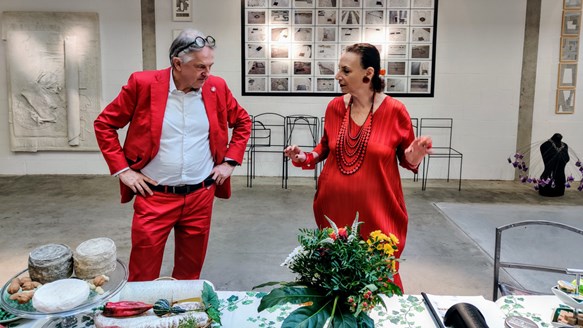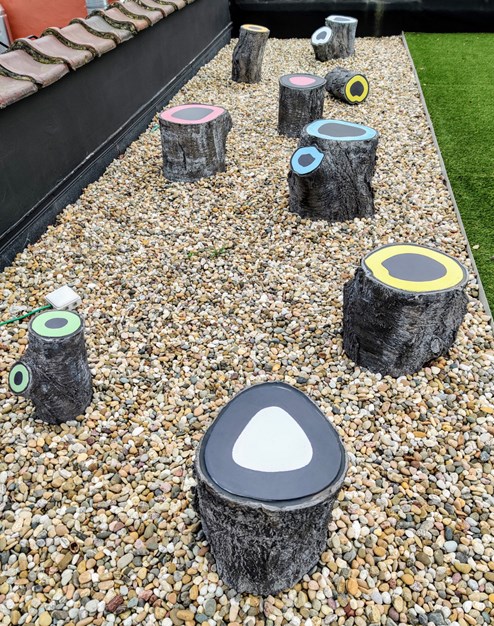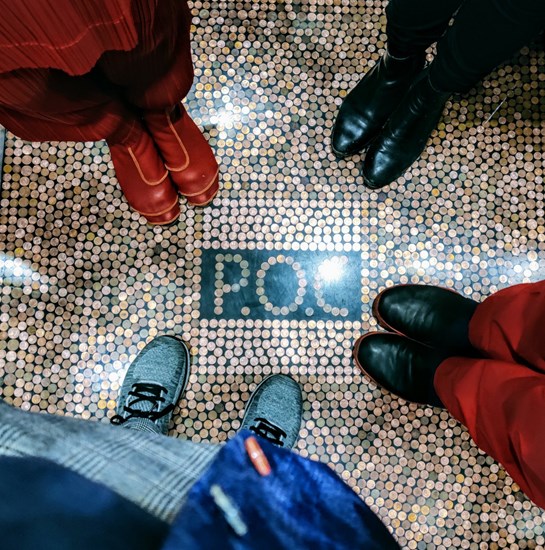
The exhibition on view at Galila’s P.O.C is called “Overdose”. Not only is the name a reference to the many artworks already present, it also hints to the everchanging nature of Galila’s P.O.C as it is the idea to keep adding more and more artworks. In fact, currently there is only one permanently integrated artwork; a beautiful staircase by Belgian designer Xavier Lust.
Image: P.O.C (Passion Obsession Collection), Etienne Verbist, Art Dependence Magazine (left), Mme Galila Barzilaï-Hollander (right), photo by Trikke Van Roey
The collector Galila Barzilaï-Hollander welcomed us to her newest venture, Galila’s Passion Obsession Collectionor Galila’s. P.O.C, on the Avenue Van Volxem 295 in Forest several months ago. A lifelong dream to open a public house for her unique ‘art family’ that is finally becoming reality.
“First, let me enlighten you a bit about the story behind this particular building; I bought it more or less 15 years ago when the area was still very run-down. I run a real estate firm and the original idea was to ultimately make money out of it since I believed that this area would become more valuable in the future. As I didn’t have any immediate use of the building, I lend it to an artists and curators’ collective called ‘Komplot.’ They were here for nearly 10 years. One day however, I realised that my own home looked more and more like a warehouse rather than a house because of all the artworks gathered there. As a result of this, could not really invite guests anymore. During this time, people even started thinking that I was a bit asocial. So, I had to do something about it. Finally, I decided that I would thus relocate some of my collection to a new space. Unfortunately, the situation in my own house is still quite the same, but that is a story for another time, …”

P.O.C (Passion Obsession Collection), Etienne Verbist, Art Dependence Magazine (left), Mme Galila Barzilaï-Hollander (right), photo by Trikke Van Roey
The decision to give her artworks a new home, resulted in Galila’s P.O.C.The former industrial building was completely refurbished by architect Bruno Corbusier; only the original façade can still be seen. He created a unique and balanced environment where the structure of the building is in harmony with the rather playful pieces in Galila’s collection.
The exhibition on view at Galila’s P.O.C is called “Overdose”. Not only is the name a reference to the many artworks already present, it also hints to the everchanging nature of Galila’s P.O.C as it is the idea to keep adding more and more artworks. In fact, currently there is only one permanently integrated artwork; a beautiful staircase by Belgian designer Xavier Lust. Galila met him a long time ago when Lust was still in his early twenties and just out of school. As she really liked what he was doing, Galila promised him that one day they would collaborate on something. Thirty years later, this promise became reality when she asked him to create a central piece for the main hall from Galila’s P.O.C.This resulted in an extra-ordinary almost ‘flowing’ staircase of stainless steel that connects the first two floors in the building.
The spirit of the P.O.C
Galila considers herself a collector who does not ‘collect’, rather she thinks about the artworks she gathered over the years more as like a family. This is also noticeable in the way she talks about them; she does not relay on art historical facts, instead she prefers to tell intimate stories on how she connects these works with parts of her life, the many anecdotes on how she got the pieces, and how they frame in her personal perception of art. Galila is not a guide but a storyteller; when you visit the collection together with her, she entrances you with the many tales she has to tell.

Anna Samat, Malaysia, Tribal Chief Series 9 & 10 2017, Bench by MAARTEN DE CELLAR Belgium, P.O.C (Passion Obsession Collection)
“I was thinking a lot about what to present here and how to show these things. I knew that I could only fit a small part of the collection in this space. So, I thought let’s start with what you in the gourmet world call a ‘meze’; you taste a bit of everything and then you know what you like. Thus, I decided to make a ‘meze’ here. It is a collection of collections; there are many themes, around twenty; money, eyes, books, chairs…The philosophy of this building is to show my mental universe in a way that there is a red thread that combines everything. Of course, the one thing that combines it all is me. Nevertheless, I feel that there is a family ambiance here. It is like a nice party; the works are not all the same genre, but they go well together. There is communication, harmony, and a dialogue in this place. Family is the keyword. This is also something that people often mention after visiting the collection. Even stiff people change their body language, I can see it on their faces.”, Galila says with a laugh.
A visit to the collection always starts, of course, at the entrance; what we see there immediately sets the tone for what we will be seeing the rest of the hour and a half we spent at Galila’s P.O.C. When speaking about the pieces, Galila does not really like to explain meaning nor analyse the works themselves. Instead, the artworks play a role in her overall narrative creation. Remarkably, no artists’ names are displayed either. She wishes for people to focus on the feelings derived from the works themselves and not from the experience of ‘recognizing’ a certain name. Overall, she wants to leave some imagination to the visitor.
Moreover, there is no hierarchy present in the collection; emerging artists are mixed with established ones and even ‘non-artworks’ are presented alongside ‘real art’. If Galila sees something she likes, she buys it: there is no, what she likes to call ‘snobbism’, involved in her choice. This becomes evident as she explains the first artwork we encounter, «Installatie III »by Dutch artist Frank Halmans showing an endless entanglement of electric cables and water pipes: “Was it the plumber, or maybe the electrician, who went a bit crazy? It does not mean anything but it is fun. It brings a smile to your face. You do not need a meaning for everything in life. It can be a trigger for something completely different, that you are not even aware of. It can generate something even if you do not know what. The process of creativity is born from things that are not really present in your conscience, but that can maybe generate something.”

Photo Trikke Van Roey, P.O.C (Passion Obsession Collection)
After, she gestures towards another artwork, « Carmen Y Don Pedro » by Jacqueline Lecarme; “It is exciting to buy objects that are not art, objects that you just really like, and then present them next to works by artists. They can still look great next to one another and have an interesting relation with each other. Here is an example of a work by a Belgian woman who usually makes jewellery; she started to create sculptures of things she bought at the flea market. I think that this lady merits to be shown because of her creative mindset. The work is made by hair combs; I would never ever have thought about presenting my hair combs in this way myself. It is very creative”.
Galila only started her contemporary art collection in 2005, exactly a year after her husband, Jacques Hollander, had passed away. The piece «A livesaving tube »by the Korean artist Tae Hun Kang, depicting a livesaving tube with the word ‘HELP’ written on it in neon light, is something she personally connects to this event: “This artwork is deep and symbolic, it relates to my universe, because it was contemporary art that was my life saver after my husband passed way; it made me go up instead of sinking down. Today this work can also relate to the pressing issues with refugees coming across the seas to seek a better life. One can also reflect upon that when looking at it.”

Photo by Trikke Van Roey, P.O.C (Passion Obsession Collection)
“I also have over one hundred videos in the collection. One of them shall be projected in the entrance, it is by an Israeli artist; a parody on curators of contemporary art taking themselves too seriously; he makes a joke out of their pretentious gestures and body language. The artist himself is a great actor so it is very funny. This video will be installed here because it shows exactly the contrary to what can be seen inside this building.”
As we finally go up the stairs, the vast open hall and its many artworks are revealed. One of the significant pieces located there is « Explaining Adulthood to Children», 2018 by Danish artist Peter Holst Henckel, a gigantic chair with an enormous jacket draped over it. This gives Galila the opportunity to explain yet another aspect of her vision: “In my universe this work represents two issues; the first is that I am a perfectionist and I aim for excellence. One has to think BIG in order to reach above average. The other issue is based completely on a human level and it is about my relation to children; I never stand straight when I talk to a child because I imagine it must be very bizarre for the child to move around in a world of giants. So, when I sit on this giant chair and my feet are hanging down, it makes me feel empathic with the world of children. It gives me the ability to see the world from their perspective. “
Why do you collect?
“Why I collect? I do not collect. On the outside wall of my home I have a work that looks like a text balloon out of a comic strip, it says: “Tell me who I am”. My collection is my personal way to communicate non-verbal statements. It is about creating my own world that makes me feel good. It is what makes me vibrate. But it is not really a question of money, for example; buying prestigious products does not give me the same excitement at all, not even an expensive car.

Stairs to first floor, by Xavier Lust, P.O.C (Passion Obsession Collection)
Regarding cars and art; I had this very old car, that I did not manage to sell. So, instead I customised it; I took out the front seats and placed TV screens there and let a patchwork be made of my old VIP art fair cards. This car is now my ‘VIP projection room.’ Ultimately, I plan for it to be brought to the courtyard of 316 avenue van Volxem, when this space is ready to open.”
Subjects of the collection and the red line
“I love to collect emerging artists. However, I don’t do anything to actively discover such artists, they often just come to me one way or another. It is truly about whether an artwork speaks to me or not. Though, I never sell artworks, I like to have the feeling that I was “right” after buying a work purely on ‘gut feeling.’ One objective of creating this venue was also to give more exposure to the artists whose works I have bought.”
As already mentioned, another unique feature to this collection is the many themes that are present, about twenty of them can be found at Galila’s P.O.C. like religion, eyes and watermelons. Money is also one amongst them. A significant piece in this theme is « Shekel – Israel » by French artist Philippe Assalit, it depicts Galila as part of a collage of bills: “This is a deep sociological and historical study of the symbolism you can see on money bills even those that are out of circulation. The artist’s ambition is to cover all the currencies in the world. First, he makes a historical study on the country, then he takes a photo of a native of the country. For Israel, he chose me (born in Tel Aviv’). Finally, he proceeds to make a montage with all the symbols he studied. Personally, I think that he would probably be able to hold a lecture on the different countries, taking the works as examples, because of the thorough research he already did on them.”
Recycling and appropriation are two other themes present. As Galila stops by « Tribal Chief Series 9 »by Malaysian artist Anna Samat, a wall piece entirely made out of recycled materials such as keychains and rake parts; “Look at the details of this; it is beautiful and powerful filled with harmony; everything looks natural, like it is in the right place. I think that you need to have the right mind in order to create something like this. I know that I would never be able to create it myself. Even if someone would put all of these objects on the floor in front of me and tell me to create something, I would just not be able to do it.”

Photo by Trikke Van Roey, P.O.C (Passion Obsession Collection)
“For me, the creative process in problem solving is really the key. I am absolutely fascinated by it, not only when discovering new artworks, but also very much in my daily life. For example; when I meet lawyers, doctors, and engineers, these are types of people that I respect a lot, but I do not know anything about their professions nor do I think like them. I may come up with different ideas and ways of doing things than them. Maybe if we combine both visions, it can open up a totally new perspective on certain matters, a 360-degree vision of some sort.”
That Galila stands for difference can also be understood when she tells us the story about the one time she was asked to hand over a CV at the age of 60: “It was important for my role in the company, and they absolutely insisted on getting it. However, I decided to not do that what they expected, I created a V.C instead of a C.V. V.C stands for Vie Cobble (fulfilled, happy life). I put together an album of photos showing my life and that could serve as a base for a discussion. I like to swim against the current.”
During the summer of 2020 two more buildings, also as part of Galila’s P.O.C, will be finalised on the same street. One will house Galila’s extensive collection of chairs; not your typical everyday chairs but rather ‘chairs as art pieces’. They are made up of original materials such as clothes, guns, ink cartridges, and even skateboards, each shaped in unique distinctive forms. Fifty of these chairs were already part of an exhibition in the Latvian National Museum of Art in 2019. The other building will house temporary exhibitions as well be used as a space for educational and corporate activities.
The role of people in the P.O.C project
Making her collection accessible to a diverse public is one of the core missions behind the creation of Galila’s P.O.C. One of the ways to realize said missions is by integrating several educational and corporate programs. For example, already in 2019 creative workshops for children inspired on the ‘recycling’ theme in collection were held in a school in Forest.

Photo by Trikke Van Roey, P.O.C (Passion Obsession Collection)
However, Galila’s P.O.C.’s unique environment is not only suitable for leisure. The disruptive character of the collection lends itself perfectly for inspirational workshops, team-buildings, team-assessments and guided visits for companies. Also, the building can be rented to hold one-of-a-kind meetings, cocktails or dinners. At Galila’s P.O.C. companies are invited to play, imagine and create.

P.O.C (Passion Obsession Collection), Mme Galila Barzilaï-Hollander, photo by Trikke Van Roey
As Galila concludes our visit: “The collection presents an opportunity for creativity and discussion. It would be a pity not to use this wonderful environment in activities for different people. I always by to say that Galila’s P.O.C is a playroom for adults where children are also allowed. Thank you for your visit, please come back, now you know where to find me.”

ArtDependence Magazine is an international magazine covering all spheres of contemporary art, as well as modern and classical art.
ArtDependence features the latest art news, highlighting interviews with today’s most influential artists, galleries, curators, collectors, fair directors and individuals at the axis of the arts.
The magazine also covers series of articles and reviews on critical art events, new publications and other foremost happenings in the art world.
If you would like to submit events or editorial content to ArtDependence Magazine, please feel free to reach the magazine via the contact page.